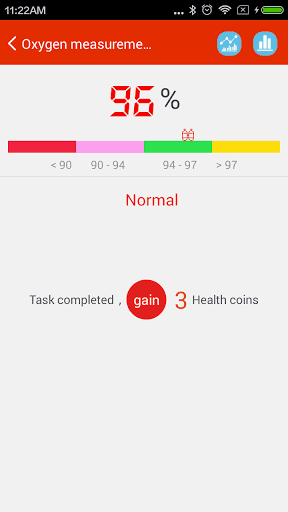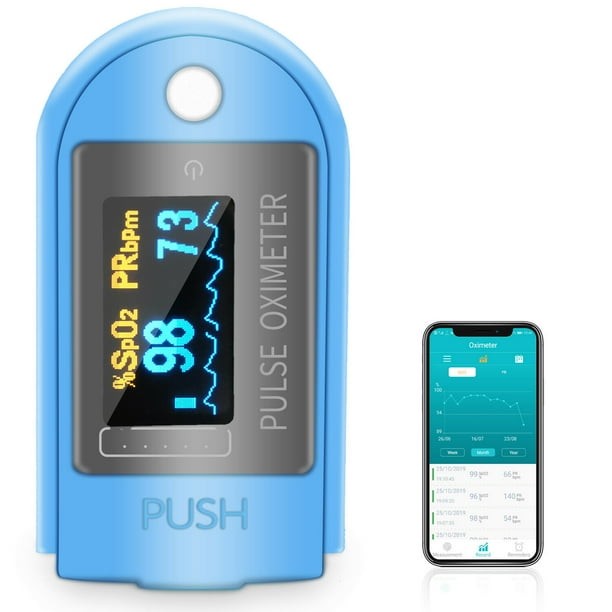94 Blood Oxygen
Pulse oximeters used to test blood oxygen levels, an increasingly common precaution during the COVID-19 pandemic, may be giving a false sense of security according to an FDA warning. People who are breathing normal, who have relatively healthy lungs (or asthma that is under control), will have a blood oxygen level of 95% to 100%. Anything between 92% and 88%, is still considered safe and average for someone with moderate to severe COPD. Oxygen saturation (also called SpO2) is a fraction of the oxygen-saturated haemoglobin, compared to the total haemoglobin in the blood. The normal values of SpO2 range from 92 to 100 percent. For a healthy person, SpO2 values usually fall between 94-96 percent. Your bloodstream must be able to circulate blood to your lungs, take up the oxygen and carry it throughout your body A problem with any of these factors — for example, high altitude, asthma or heart disease — might result in hypoxemia, particularly under more extreme conditions, such as exercise or illness.
Overview
What is hypoxemia?
Hypoxemia occurs when levels of oxygen in the blood are lower than normal. If blood oxygen levels are too low, your body may not work properly.
Blood carries oxygen to the cells throughout your body to keep them healthy. Hypoxemia can cause mild problems such as headaches and shortness of breath. In severe cases, it can interfere with heart and brain function. Hypoxemia that causes low oxygen levels in your body’s tissues is called hypoxia. Sometimes people use the two terms interchangeably, but they are not the same thing.
Symptoms and Causes
What causes hypoxemia?
A variety of conditions and circumstances can interfere with the body’s ability to deliver normal levels of oxygen to the blood. Some of the most common causes of hypoxemia include:

- Heart conditions, including heart defects
- Lung conditions such as asthma, emphysema, and bronchitis
- Locations of high altitudes, where oxygen in the air is lower
- Strong pain medications or other problems that slow breathing
- Sleep apnea (impaired breathing during sleep)
- Inflammation or scarring of the lung tissue (as in pulmonary fibrosis)
What are the symptoms of hypoxemia?
Symptoms of hypoxemia vary depending on the severity of the condition. They include:
- Shortness of breath
- Fast heartbeat
- Coughing
- Confusion
- Bluish color in skin, fingernails, and lips
Diagnosis and Tests
How do doctors diagnose hypoxemia?

To diagnose hypoxemia, your doctor will do a physical examination to listen to your heart and lungs. Abnormalities in these organs can be a sign of low blood oxygen. Your doctor may also check to see if your skin, lips, or fingernails look bluish.
Doctors use tests to check your oxygen levels, including:
- Pulse oximetry: A sensor that slips over your finger measures the amount of oxygen in your blood. Pulse oximetry is painless and noninvasive. Many doctors use it routinely each time you visit.
- Arterial blood gas test: A needle is used to take a blood sample from your artery to measure the levels of oxygen in your blood.
- Other breathing tests: These might involve breathing into tubes that are connected to computers or other machines.
Management and Treatment
How do doctors treat hypoxemia?
Treatment for hypoxemia aims to raise the levels of oxygen in the blood. Doctors can use medications to treat underlying conditions that cause hypoxemia. These medications are often given through an inhaler that enables you to breathe the medicine into your lungs.
In more severe cases, your doctor may prescribe oxygen therapy. People typically receive extra oxygen through a device called a cannula (tube) that is clipped to the outside of the nose, or through a breathing mask. The location and amount of time people receive oxygen therapy is based on individual needs. You may receive oxygen at home, with a portable machine while you travel, or in the hospital.
What are the complications or side effects of hypoxemia?
If your blood does not have enough oxygen, it cannot deliver enough oxygen to the organs and tissues that need it. This situation can be fatal if severe in the short term and can affect the heart or brain if it persists over a long period of time.
Prevention
Can hypoxemia be prevented?
There are steps you can take to prevent hypoxemia from returning after treatment. To increase the oxygen levels in your blood, your doctor may recommend:
- Deep breathing exercises
- Mild exercise such as walking or yoga
- Eating a healthy diet
- Drinking plenty of water
- Quitting smoking
Outlook / Prognosis
What is the outlook for people with hypoxemia?

Hypoxemia symptoms can go away with treatment. Depending on the cause, people with hypoxemia may require treatment once or on an ongoing basis. Your doctor will work with you to manage the condition so you can live an active, healthy life.
Living With
When should I call a doctor regarding hypoxemia?
Contact your doctor if you experience symptoms of hypoxemia. Early diagnosis and treatment can help ensure the condition does not get worse and cause dangerous complications.
Oxygen is drawn into the body from the atmosphere by breathing. Each lung is inundated by an estimate of 300 million alveoli, which are cocooned by numerous blood capillaries. Alveolar walls and capillary walls are extremely thin, this makes them permeable, therefore, oxygen passing into the alveoli immediately diffuses into the blood capillaries – the process takes up only .25 seconds in an adult at rest. The bulk of oxygen that diffuses into the blood binds itself to hemoglobin molecules that are found in red blood cells creating oxyhemoglobin. The smaller bulk of the oxygen that is left over dissolves into the blood plasma. Blood that is rich in oxygen (arterial blood) then flows through pulmonary veins, into the left atrium and left ventricle, and finally circulates throughout the entire body’s organs and their cells.

Carbon Dioxide, which is a byproduct of cell metabolism, dissolves in the blood and is circulated back to the lungs where it is released as fresh oxygen attaches itself to hemoglobin and the cycle is replicated and repeated over and over again. The total amount of oxygen that is transported around the body is shaped by many factors: the lung factor which is the degree to which hemoglobin binds to oxygen, the anemic factor which is the hemoglobin concentration and the cardiac factor which is essentially the cardiac output. Oxygen saturation levels are an indicator of oxygen transportation in the body and point to whether oxygen is being supplied to the body, especially to the lungs in sufficient amounts.
What is SPO2
The pulse oximeter makes use of two frequencies of light (red and infrared) in order to gauge the percentage (%) of hemoglobin present in the blood that is dense with oxygen. The percentage calculated is called Blood Oxygen Saturation or SPO2. Hemoglobin molecules with attached oxygen molecules (Hbo2) absorb a different level of red and infrared light in comparison to hemoglobin molecules, which don’t have any oxygen molecule, attached (Hg). The difference range between absorption using an infrared light and a red light is used to gauge the SpO2 percentage. Each hemoglobin molecule can carry a load of four oxygen atoms and SPO2 is the sum percentage of hemoglobin molecules, which are oxygen-rich. Pulse oximeters also measure and display the pulse rate while measuring the SPO2 levels.
SpO2 readings are recorded in percentages. Normal levels of SpO2 rest between range of 95-100%.
SPO2 Levels
Blood Oxygen Saturation levels can be read as follows:
- 90% or less: This is the red zone; you need to consider consulting your doctor.
- 91 to 94%: This percentage is lower than average for the population. It requires you to monitor your situation closely.
- 95 to 100%: This is the average for the majority of the population, the SPO2 normal values. This level indicates that your red blood cells are dense with oxygen, meaning they are transporting oxygen around the body sufficiently and efficiently.
Blood oxygen saturation levels that fall outside the range of 95 to 100% can cause a number of symptoms. Some of them are as follows:
- Trouble breathing
- Shortness of breath
- Increased heart rate
- A headache
- Confusion
- Chest pain
Acute and persistently lowSpO2 levels leads to a condition called Hypoxemia. Hypoxemia can pave way for various health issues including organ failure. Low oxygen levels can also cause serious problems such as lung disease and sleep apnea. These conditions may require additional oxygen to maintain the healthy functioning of cells and prevent long-term damage to them. Hypoxia can also be caused by asthma, emphysema, pneumonia, heart problems, and anemia.
During exercise, SpO2 levels gauge the amount of oxygen that is reaching the muscles during a regular workout. This is why it is extremely important to know SpO2 levels just after any sort of activity. High blood oxygen levels indicate that the body will transport oxygen throughout the body at a faster rate, which will, in turn, make workouts efficient and intense. Lowblood oxygen level mean that the body will transport oxygen to the muscles at a slower pace, which will cause fatigue and make the workout less effective. Essentially, blood oxygen saturation gauges the quality of heart and lung health. Lower readings indicate that the tester is unfit or suffers from an ailment or illness.
In addition, one of the biggest negative influences of lung health is smoking. Smokers tend to experience drastic improvements in both their mental and physical health if they can gain control of their habit or completely curb it. Changes include better mood regulation, increased lung capacity, and improved fitness levels, and an overall increase in energy levels.
Moreover, there are a variety of ways you can work to improve your blood oxygen level.
- Exercise: During workouts, the body has to work hard to keep SpO2 levels up. This can over time permanently increase SpO2 levels even when you are not exercising. An hour of aerobic exercise, for example, brisk walking, jogging, swimming, or dancing at least three times a week can make a marked improvement in your SpO2 levels.
- Fresh air: Sounds funny, but you can also increase oxygen levels by simply increasing the amount of oxygen you breath. Working out outside often can do this, opening windows in your house or offices, and increasing the number of live plants in your surroundings. These small changes will increase your fresh oxygen intake.
- Diet: Consuming foods such as raw fruits, green vegetables, seeds, and nuts will draw more oxygen into the blood and markedly improve SpO2 levels over time as they are rich in chlorophyll.
- Deep breathing: Oxygen deficiency can be dealt with by practicing deep breathing for a few minutes each day. Deep breathing entails filling the lungs to full capacity by expanding the chest and abdomen.
Is 94 Blood Oxygen Level Low

94% Blood Oxygen Level
Understanding blood oxygen levels is important for everyone. However, it is particularly useful for those who exercise and is essential for people who suffer from low blood oxygen levels, such as those diagnosed with sleep apnea. However, while SPO2 provides an insight into your blood oxygen level, it is not a complete and comprehensive measurement of a person’s health. SPO2 measurements with an SPO2 sensor or an SPO2 monitor simply merely indicate that a diagnostic testing is needed, or other treatments should be taken into consideration.
